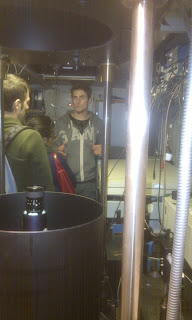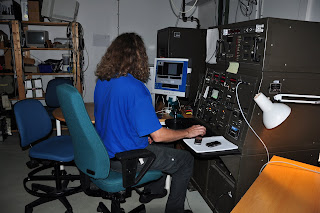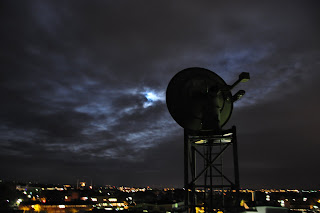The 12–16 December 2011, there will be a course in R, available for all CAnMovians. Read more and register: http://www.geneco.se/Courses/Autumn-2011/Introduction-to-using-R.
tisdag 27 september 2011
Course in R
onsdag 21 september 2011
Workshop on Climate Change
10-12 October there will be a workshop called "Beyond the Climate Envelope" and there will be talks and discussions about how to find new approaches for detecting climate impacts and predicting the future. The workshop is a cooperation between CAnMove and BECC (Biodiversity and Ecosystem services in a Changing Climate).
This workshop is open for registration until friday (23 September) and more information about the workshop and how to register you can find here.
This workshop is open for registration until friday (23 September) and more information about the workshop and how to register you can find here.
tisdag 13 september 2011
Moon watching has begun
 |
| Patrik talks about LIDAR |
Thereafter the group joined the rest of the team on the roof of the Ecology Building where the tracking radar was demonstrated by Johan Bäckman and hotdogs and drinks were served to the interested audience.
 |
| Johan demonstrates the radar |
 |
| Waiting for the moon to show |
 |
| The radar "saw" a lot more birds than we did this night |
The CAnMove personnel lead by Helena and Johan made the evening a very pleasant and exciting event! Thank you!
Susanne
torsdag 1 september 2011
CAnMove at Innovation in Mind 2011
 |
| Lund University at night. |
CAnMove coordinator will participate in the
opening of the 2011 Innovation in Mind conference at Lund University covering
the topic: Is innovation what you think it is? The conference will open to the
music of Björn J:son Lind and at the same time a preview of the film production “Fåglarnas
svarta låda” covering new tracking technology to study bird movements by journalist Joakim Lindhé will be shown. The conference will be
held at a temporary conference venue at the University building 14-15 September. This years conference focus
on social innovations and alternative views of the concept of innovation.
Participants may expect a spectacular event.
Susanne
Remote nocturnal bird classification by spectroscopy
 |
| The LIDAR bus at the field site during the Kullaberg campaign May 2010. Photo: Mikkel Brygdegaard. |
In a recent paper by P. Lundin et al. (2011; doi:10.1364/AO.50.003396)
published in the July issue of Applied Optics a team of scientists from two of
the Linnaeus environments at Lund University, Lund Laser Centre and CAnMove,
report on new optical methods at a wide range of wavelengths used for remote bird
classification. The team applied a variety of methods including eye-safe
fluorescence and depolarization lidar techniques, passive scattering
spectroscopy, and infrared (IR) spectroscopy in the field campaign at Kullaberg
spring 2010. In this paper the team has refined the previously presented method
of remotely classifying birds by using laser-induced beta-keratin fluorescence.
Phenomena of excitation quenching were studied in the laboratory and were
theoretically discussed in detail in the paper. It is shown how the ordered
microstructures in bird feathers induce structural "colours" in the
IR region with wavelengths of around 3-6 mu m. We show that transmittance in
this region depends on the angle of incidence of the transmitted light in a
species-specific way and that the transmittance exhibits a close correlation to
the spatial periodicity in the arrangement of the feather barbules. Furthermore,
we present a method by which the microstructure of feathers can be monitored in
a remote fashion by utilization of thermal radiation and the wing beating of
the bird.
The application of these remote techniques in
bird migration studies is novel and shows a high potential to finally resolve
the question what bird species are flying above in a pitch dark night sky. I
find it exciting to see how CAnMove in this innovative way can contribute to
development and application of new technology and how the field of animal
movement research may benefit from these findings.
Susanne
Prenumerera på:
Inlägg (Atom)
